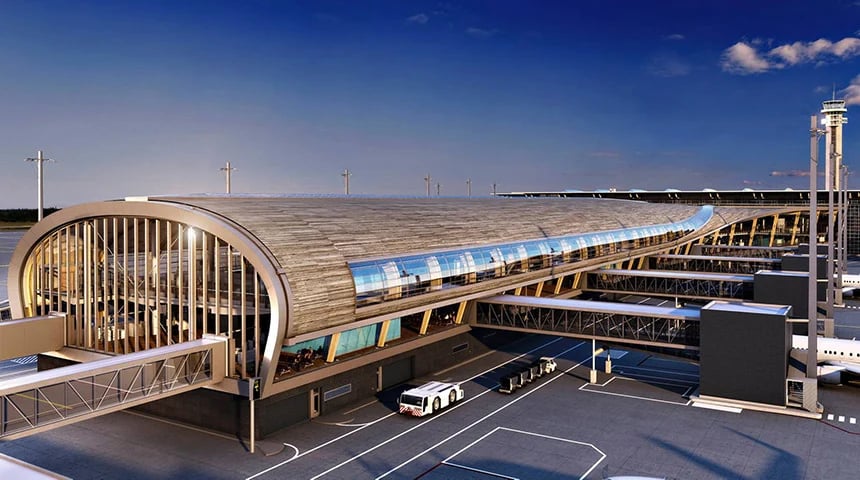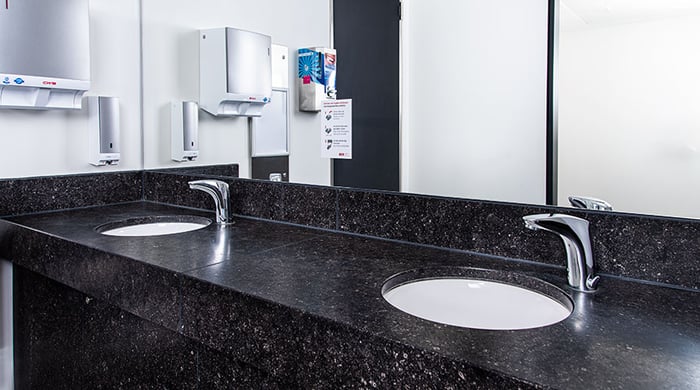As safety and hygiene move to the top of airport planners’ priority list, what solutions are they deploying to keep passengers comfortable and secure?

Few sectors have been hit harder than the aviation industry in 2020, with revenues forecast to fall by over a billion and air traffic down to a minimum. And it isn’t just airlines that have been suffering the impact of the Covid-19 pandemic — airports worldwide have seen passenger numbers fall by almost 60% in the first half of 2020.
Yet here, as a potential silver lining, the pandemic has planners considering how safety and comfort will be shaping the design of future terminals. They’re looking at everything from smoother security checks to an enhanced shopping experience, all while ensuring passengers a safe and secure journey.
“We have to give passengers confidence that it is safe to fly. And that gives us a chance to really rethink the passenger experience,” Ty Osbaugh from Gensler’s Aviation practice tells Forbes.
The airport of the future will undoubtedly seek to make travel more enjoyable and less stressful. And while many renovation projects in 2020 have been paused due to the pandemic, we look at what’s in store for airport planners to ensure both a safe and enjoyable experience.

Touchless HANSA faucets at Berlin airport help improve hand hygiene significantly.
1. Are we heading towards touchless travel?
Airport planners expect to see a higher level of digitalisation in airports in the months to come, to make passengers feel safer when travelling.
This can come in many different forms: from devices that prevent spaces from overcrowding, to touchless check-in kiosks and automatic faucets that can mitigate the spread of germs and bacteria in frequently used airport bathrooms, while promoting hand-washing.
"Airports have been quicker to adopt touchless travel than aircraft cabins," says Matt Round, chief creative officer at London-based design consultancy Tangerine, to CNN. "We are already seeing touchless security, and more and more processes are moving out of airport infrastructure and into the digital world thereby reducing the number of contact points in the airport.”
2. Hands-free services and devices in bathrooms
Bathrooms in airports are used by tens of thousands of people a day. And an increasing number of airports around the world are making use of sensors that can detect the number of people using the facilities, allowing them to assess how often they should be cleaned.
And inside bathrooms, installing hands-free devices – including soap dispensers, towel dispensers, toilets and doors – is considered one of the most effective ways to ensure higher hygiene standards.
HANSA’s range of touchless bathroom faucets, for example, are a viable solution for airports around the world — providing planners with a range of touchless devices for bathrooms that can help reduce the spread of the virus and harmful microbes, and keep hands clean.
3. Bluetooth enabled touchless faucets can add an extra layer of hygiene security
Many HANSA touchless faucets come with Bluetooth functionality that makes it possible to manage and control each fixture through an app.
For airports that have seen a dramatic decrease in passengers, this is particularly useful for mitigating the risk of spreading legionella through stagnant water. These HANSA faucets can automatically flush installations that aren’t in use every 72 hours — and the frequency and duration of automatic flushes can be increased or decreased through the app for each faucet.
As an example, Frankfurt Airport, which in normal times would welcome up to 250,000 passengers per day, has taken advantage of lower passenger numbers to concentrate its operations in one terminal. And here, facility managers recognise how the HANSA automatic flush feature made their job much easier.
“The partial closure makes it necessary to flush the installations that aren’t in use every 72 hours,” says Hubert Ball, Facility Management, Betriebsingenieure Terminals, IFM-TTI. “And with HANSA SMART faucets we can do it automatically, while the single-lever mixer faucets still require manual flushing.”
As airport planners respond to the increased demand for hygiene and safety, they are taking a holistic approach to digitalisation that includes a wide range of touchless solutions. Bluetooth-enabled SMART touchless faucets not only help decrease the spread of harmful microbes, but they can also help mitigate the risk of legionella. Part of a wider health & safety strategy, SMART faucets can play an important role in a safer, more comfortable passenger experience.






